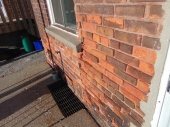



Gilbert Fritz wrote:Bill, it has been a long time since I read Christopher Alexander's books, but I seem to recall that he used the Christian churches of medieval Europe as examples of his patterns, and a quick search on google books seems to confirm that.

Tom Kozak wrote:Hi All,
My house was built with bricks in 1814. Most of those bricks are still sound but a few are badly spalling (spaling, spalding, spallding?). I do have a large supply of period bricks (from an interior wall in the basement). The worst of the bricks I will chip out and replace, but there are large areas near the foundation where ALL the bricks are spalling. I'd like to just parge coat around the whole house up to about 3 feet. Is this a good idea?
You absolutely must use a lime based as in no OPC mortar.Tom Kozak wrote:
concerns/questions;
1. what kind of mortar should I use around the replacement bricks?
You have a house that is 200 years old, is your new fix going to be better than what is already there? The real question is when did this start to be a problem? My guess is just a few years after the cement walkways were installed leaving the moisture under the sidewalk nowhere to go but through your porous lime mortared low fired clay brick and leaving a calcium salt efflorescence on the surface of the brick as evidence of it's origin.Tom Kozak wrote:2. is parging spalled brick a bad idea? if not what is the pest method of doing this/best product to use?
Yes, Siloxane, but this is not necessary if you jackhammer that concrete.Tom Kozak wrote:3. is there a clear finish/sealer I can put on the entire wall after the parge coat that will let moisture in but not out?
Yes, but make sure he has real credentials and at least 25 years experience in historic masonry. No to the water sealer, not ever!Tom Kozak wrote:4. should I hire a local bricklayer to have a look at the place and tell me what to do?



this is in Sudbury Ontario (we get short hot summers, long cold winters and A LOT of snow).
a friend had recomended spraying with Tompson Water Sealer but said that would only be a temporary measure and I'd have to re-do it at least once a year.
thanks
TomK